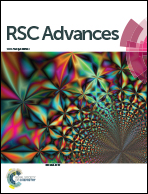Silica-coated gradient alloy quantum dots with high luminescence for converter materials in white light-emitting diodes†
Abstract
Hydrophobic gradient alloy quantum dots (QDs) were prepared through a facile organic route. The amphiphilic, non-ionic polymer (PVP) was absorbed onto the surface of QDs, and therefore, the PVP coated QD (QD@PVP) could be dispersible in both polar and non-polar solvents. The QD@PVP was dispersed in ethanol and tetraethyl orthosilicate (TEOS) was added with a basic catalyst in order to generate silica shell encapsulated QDs (QD@SiO2). We report a preparation method for QD@SiO2 that maintains their high luminescence and thermal- and photo-stability using dimethylamine (DMA) as a basic catalyst. White light-emitting-diodes (WLEDs) incorporating the QD@SiO2 exhibited good performance in terms of superior luminescence efficiency and high color purity.



 Please wait while we load your content...
Please wait while we load your content...